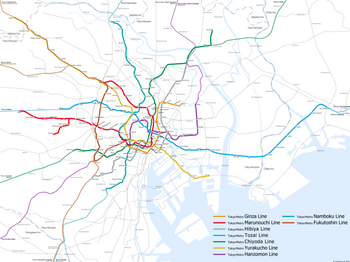Tōkyō Metro
Tokyo Metro ( Japanese 東京 メ ト ロ , Tōkyō Metoro ) is the name of one of two subway systems in the Japanese capital, Tokyo .
The operator is the Tōkyō Chikatetsu KK ( 東京 地下 鉄 株式会社 , Tōkyō Chikatetsu Kabushiki-gaisha , German "Tokio-U-Bahn-Aktiengesellschaft", English Tokyo Metro Co., Ltd. ). In 1941 she was named Eidan ( 帝都 高速度 交通 営 団 , Teito Kōsokudo Kōtsū Eidan , "Imperial City Express Transport Company ") for the expansion of the Ginza Line and the construction of seven other lines (Marunouchi, Hibiya, Tōzai, Chiyoda, Yūrakuchō, Hanzumon and Nambokuchō ) founded. The authority was converted to the Tōkyō Chikatetsu KK in 2004 , with the Tokyo prefecture government holding 46.6% and the Japanese government holding 53.4% of the shares.
Today Tokyo Metro uses 9 lines to transport 5.8 million passengers a day over 192 km of route and 141 stations. The company achieved a profit of 43.53 billion yen in the 2005 financial year , making it the world's only profitable subway operator alongside the Hong Kong subway .
Gauge and binding
The two oldest lines ( Ginza and Marunouchi ) use standard gauge (1435 mm gauge ). Power is supplied via a busbar attached to the side with 600 V direct current .
All other Tokyo Metro lines run on tracks with a gauge of 1067 mm ( cape gauge ) and get their power from an overhead line (1500 V direct current). The 1067 mm track gauge is widely used in Japan. This enabled these subway lines to be linked through to suburban rail lines at the terminus . The underground trains continue to run on the suburban lines operated by other railway companies. Conversely, some suburban trains also run as subways on the line sections of the Tokyo Metro.
Fare
Tokyo Metro charges 170 yen for the first six kilometers. There are several price levels up to a maximum of 310 yen from 28 km. Children pay half that, rounded up to a full 10 yen.
There is no transport or tariff association in Tokyo. If Tokyo Metro's passengers change to another operator's line, the fare is calculated based on the individual company's routes, minus a small discount. The bottom line is that this is relatively expensive because two short trips cost more than one longer one. In this case, tied journeys also count separately, although the passengers remain seated on the same train.
We therefore recommend 72-hour tickets for tourists, which are available at airports, from tourist information offices and in selected shops and hotels and which entitle you to use the entire metro lines in Tokyo. Adults pay 1500 yen for this.
Lines
Tōkyō Metro operates the following lines:
| Surname | route | Train stations | length | Connection to other lines | |
|---|---|---|---|---|---|
| G | Ginza line | Shibuya - Asakusa | 18th | 14.3 km | - |
| M. | Marunouchi line | Ikebukuro - Ogikubo | 24 | 24.2 km | - |
| m | (Branch line) (~ 分岐 ) | Nakano-sakaue − Hōnanchō | 3+ | 3.2 km | |
| H | Hibiya lineage | Naka-meguro - Kita-Senju | 21st | 20.3 km | Tōkyū Tōyoko Line , Tōbu - Isesaki Line |
| T | Tōzai line | Nakano - Nishi-Funabashi | 22nd | 30.8 km | JR - Chūō-Sōbu Line , JR- Sōbu Line , Tōyō - Kōsoku Line |
| C. | Chiyoda line | Yoyogi-uehara-Ayase | 19th | 21.9 km | JR Jōban Line , Odakyū Odawara Line , Odakyū Tama Line |
| (Feeder line) (~ 支線 ) | Ayase – Kita-Ayase (change required) | 1+ | 2.1 km | - | |
| Y | Yūrakuchō line | Wakōshi - Shin-Kiba | 24 | 28.3 km | Tōbu- Tōjō Main Line , Seibu-Yūrakuchō Line |
| Z | Hanzōmon line | Shibuya Oshiage | 14th | 16.9 km | Tōkyū Den'entoshi Line , Tōbu-Isesaki Line |
| N | Namboku line | Akabane-iwabuchi - Meguro | 19th | 21.3 km | Tōkyū Meguro Line , Saitama - Kōsoku Line |
| F. | Fukutoshin line | Wakōshi - Shibuya | 16 | 20.2 km | Tōbu- Tōjō Main Line , Seibu-Yūrakuchō Line |
See also: Tokyo Subway
Web links
- Official homepage of the Tokyo Metro (English)
- Tokyo Rail Map (eng. Jp.)
Individual evidence
- ↑ Tokyo Metro | Regular Tickets / Coupon Tickets. Retrieved July 7, 2019 .
- ↑ Tokyo Metro | Tokyo Subway Ticket. Retrieved July 7, 2019 .

